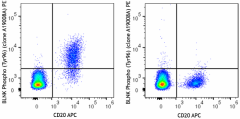- Clone
- A19008A (See other available formats)
- Regulatory Status
- RUO
- Other Names
- B Cell Linker, SLP-65, BLNK-S, BASH
- Isotype
- Mouse IgG1, κ
- Ave. Rating
- Submit a Review
- Product Citations
- publications

-

Human peripheral blood lymphocytes were treated with (left) or without (right) IgM (12 µg/mL) for 3 minutes, fixed with Fixation Buffer (Cat. No. 420801), permeabilized with True-Phos™ Perm Buffer (Cat. No. 425401), then stained intracellularly with anti-human CD20 APC and anti-human BLNK Phospho (Tyr96) (clone A19008A) PE.
| Cat # | Size | Price | Quantity Check Availability | Save | ||
|---|---|---|---|---|---|---|
| 382203 | 25 tests | 128€ | ||||
| 382204 | 100 tests | 296€ | ||||
B cell linker protein (BLNK), an adapter protein molecule, which plays important roles in B cell antigen receptor (BCR) engagement and B cell activation. Cross-linking of the BCR stimulates various downstream signaling pathways involved in cell proliferation and apoptosis. Intracellular protein tyrosine kinases such as Syk and Lyn have been implicated in this BCR signal transduction and are thought to play an important role in B cell development. The two forms of BLNK, p68 and p70, arise from alternate splicing of the human BLNK gene transcript. Syk is responsible for the tyrosine phosphorylation of B cell linker protein (BLNK), a member of the SLP-76 family of adapter proteins. Phosphorylation of human BLNK at tyrosines 84, 178, and 189 (Y84, Y178, and Y189) creates docking sites for effector proteins GRB2, Vav, Nck and PLCγ2, which in turn leads to the activation of downstream signaling pathways.
Product DetailsProduct Details
- Verified Reactivity
- Human
- Antibody Type
- Monoclonal
- Host Species
- Mouse
- Immunogen
- Synthetic peptide of human BLNK (phosphorylated at Tyr 96)
- Formulation
- Phosphate-buffered solution, pH 7.2, containing 0.09% sodium azide and BSA (origin USA)
- Preparation
- The antibody was purified by affinity chromatography and conjugated with PE under optimal conditions.
- Concentration
- Lot-specific (to obtain lot-specific concentration and expiration, please enter the lot number in our Certificate of Analysis online tool.)
- Storage & Handling
- The antibody solution should be stored undiluted between 2°C and 8°C, and protected from prolonged exposure to light. Do not freeze.
- Application
-
ICFC - Quality tested
- Recommended Usage
-
Each lot of this antibody is quality control tested by intracellular immunofluorescent staining with flow cytometric analysis. For flow cytometric staining, the suggested use of this reagent is 5 µL per million cells in 100 µL staining volume or 5 µL per 100 µL of whole blood. It is recommended that the reagent be titrated for optimal performance for each application.
- Excitation Laser
-
Blue Laser (488 nm)
Green Laser (532 nm)/Yellow-Green Laser (561 nm)
- RRID
-
AB_2924580 (BioLegend Cat. No. 382203)
AB_2924580 (BioLegend Cat. No. 382204)
Antigen Details
- Structure
- Human BLNK is 456 amino acids (aa) in length and it contains a Prorich region (aa 98260) and one SH2 domain (aa 346453).
- Distribution
-
Cytosol, plasma-membrane associated, B cells
- Function
- Links B cell receptor engagement with downstream signaling events
- Interaction
- PLCG1, PLCG2, VAV1, NCK1, VAV3, GRB2, FYN, LYN, SYK
- Molecular Family
- Phospho-Proteins
- Antigen References
-
- Fu C, et al. 1998. Immunity 9:93-103.
- Ishiai M, et al. 1999. Immunity 10:117-25.
- Baba Y, et al. 2001. Proc. Natl. Acad. Sci. USA 98:2582-6.
- Tsuji S, et al. 2001. J. Exp. Med. 194:529-39.
- Chiu CW, et al. 2002. EMBO. J. 21:6461-72.
- Taguchi T, et al. 2004. Immunology. 122:575-82.
- Gene ID
- 29760 View all products for this Gene ID
- UniProt
- View information about BLNK Phospho Tyr96 on UniProt.org
Related Pages & Pathways
Pages
Related FAQs
- What type of PE do you use in your conjugates?
- We use R-PE in our conjugates.
Other Formats
View All BLNK Phospho Tyr96 Reagents Request Custom Conjugation| Description | Clone | Applications |
|---|---|---|
| PE anti-human BLNK Phospho (Tyr96) | A19008A | ICFC |
Compare Data Across All Formats
This data display is provided for general comparisons between formats.
Your actual data may vary due to variations in samples, target cells, instruments and their settings, staining conditions, and other factors.
If you need assistance with selecting the best format contact our expert technical support team.
-
PE anti-human BLNK Phospho (Tyr96)

Human peripheral blood lymphocytes were treated with (left) ...
 Login / Register
Login / Register 












Follow Us